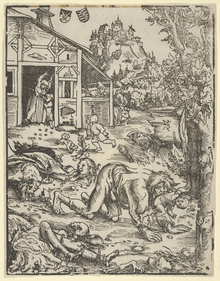Werewolf
From Wikipedia, the free encyclopedia
For other uses, see Werewolf (disambiguation).
"Wolf man" and "Lycanthrope" redirect here. For other uses, see Wolf man (disambiguation) and Lycanthrope (disambiguation).
"Lycanthropy" redirects here. For other uses, see Lycanthropy (disambiguation).
|
Woodcut of a werewolf attack, by Lucas Cranach the Elder, 1512
| |
| Grouping | Legendary creature |
|---|---|
| Sub grouping | Lycanthrope |
| Similar creatures | Therianthropy, revenant,vampire, yōkai |
| Country | England |
| Region | The Americas, Europe, Asia,Africa |
A werewolf (from Old English: were, "man") or lycanthrope (Greek: λυκάνθρωπος, lykánthropos: λύκος, lykos, "wolf", and ἄνθρωπος, anthrōpos, "human") is a mythological or folkloric human with the ability to shapeshiftinto a wolf or a therianthropic hybrid wolf-like creature, either purposely or after being placed under a curse or affliction (e.g. via a bite or scratch from another werewolf). Early sources for belief in lycanthropy are Petronius(27–66) and Gervase of Tilbury (1150–1228).
The werewolf is a widespread concept in European folklore, existing in many variants which are related by a common development of a Christian interpretation of underlying European folklore which developed during themedieval period. From the early modern period, werewolf beliefs also spread to the New World with colonialism. Belief in werewolves developed in parallel to the belief in witches, in the course of the Late Middle Ages and the Early Modern period. Like the witchcraft trials as a whole, the trial of supposed werewolves emerged in what is now Switzerland (especially the Valais and Vaud) in the early 15th century and spread throughout Europe in the 16th, peaking in the 17th and subsiding by the 18th century. The persecution of werewolves and the associated folklore is an integral part of the "witch-hunt" phenomenon, albeit a marginal one, accusations of werewolfery being involved in only a small fraction of witchcraft trials.[1] During the early period, accusations of lycanthropy (transformation into a wolf) were mixed with accusations of wolf-riding or wolf-charming. The case ofPeter Stumpp (1589) led to a significant peak in both interest in and persecution of supposed werewolves, primarily in French-speaking and German-speaking Europe. The phenomenon persisted longest in Bavaria and Austria, with persecution of wolf-charmers recorded until well after 1650, the final cases taking place in the early 18th century in Carinthia and Styria.[2]
After the end of the witch-trials, the werewolf became of interest in folklore studies and in the emerging Gothic horror genre; werewolf fiction as a genre has pre-modern precedents in medieval romances (e.g. Bisclavret andGuillaume de Palerme) and developed in the 18th century out of the "semi-fictional" chap book tradition. The trappings of horror literature in the 20th century became part of the horror and fantasy genre of modern pop culture.
Contents
[hide]Names
| Look up lycanthropy in Wiktionary, the free dictionary. |
| Look up loup-garou in Wiktionary, the free dictionary. |
| Look up werewolf in Wiktionary, the free dictionary. |
Further information: Therianthropy
The word werewolf continues a late Old English wer(e)wulf, a compound of were "man" and wulf "wolf". The only Old High German testimony is in the form of a given name, Weriuuolf, although an early Middle High Germanwerwolf is found in Burchard of Worms and Berthold of Regensburg. The word or concept does not occur in medieval German poetry or fiction, gaining popularity only from the 15th century. Middle Latin gerulphus Anglo-Normangarwalf, Old Frankish *wariwulf.[3][4] Old Norse had the cognate varúlfur, but because of the high importance of werewolves in Norse mythology, there were alternative terms such as ulfhéðinn ("one in wolf-skin", referring still to the totemistic or cultic adoption of wolf-nature rather than the superstitious belief in actual shape-shifting). In modern Scandinavian also kveldulf "evening-wolf", presumably after the name of Kveldulf Bjalfason, a historical berserker of the 9th century who figures in the Icelandic sagas.
The term lycanthropy, referring both to the ability to transform oneself into a wolf and to the act of so doing, comes from Ancient Greek λυκάνθρωπος lukánthropos (from λύκος lúkos "wolf" and ἄνθρωπος, ánthrōpos "human".[5]The word does occur in ancient Greek sources, but only in Late Antiquity, only rarely, and only in the context of clinical lycanthropy described by Galen, where the patient had the ravenous appetite and other qualities of a wolf; the Greek word attains some currency only in Byzantine Greek, featuring in the 10th-century encyclopedia Suda.[6] Use of the Greek-derived lycanthropy in English occurs in learned writing beginning in the later 16th century (first recorded 1584 in The Discoverie of Witchcraft by Reginald Scot, who argued against the reality of werewolves; "Lycanthropia is a disease, and not a transformation." v. i. 92), at first explicitly for clinical lycanthropy, i.e. the type of insanity where the patient imagines to have transformed into a wolf, and not in reference to supposedly real shape-shifting. Use of lycanthropy for supposed shape-shifting is much later, introduced ca. 1830.
Slavic uses the term vlko-dlak (Polish wilkołak, Czech vlkodlak, Slovak vlkolak, Serbo-Croatian вукодлак - vukodlak, Slovenian volkodlak, Bulgarian върколак/vrkolak, Belarusian ваўкалак/vaukalak, Ukrainian вовкулака/vovkulaka), literally "wolf-skin", paralleling the Old Norse ulfhéðinn. However, the word is not attested in the medieval period. The Slavic term was loaned into modern Greek as Vrykolakas. Baltic has related terms, Lithuanian vilkolakis and vilkatas, Latvian vilkatis and vilkacis. The name vurdalak (вурдалак) for the Slavic vampire ("ghoul, revenant") is a corruption due to Alexander Pushkin, which was later widely spread by A.K. Tolstoy in his novella The Family of the Vourdalak (composed in French, but first published in Russian translation in 1884).
Greek λυκάνθρωπος and Germanic werewulf are parallel inasmuch as the concept of a shapeshifter becoming a wolf is expressed by means of a compound "wolf-man" or "man-wolf".

No comments:
Post a Comment